This is one of the presentations that I’ve created for visitors to PNG, especially those folks who plan on visiting the Sepik River area. The original format was PowerPoint, but loading a PP here has proved to be a problem. I’ve converted the PP to a PDF file which can be navigated through. 90% is the best size to view this on. I’m working on developing these talks into something more web friendly than this minimalist PDF. Stay tuned.
The Art of Papua New GuineaMonth: May 2018
Modernity and Tradition at Home and Away
As Zoey and I return home from our morning walk around the city, she’s drawn in to a number of rapid fire conversations with her kampung friends (she spends more time out playing everyday with friends now; Grandpa time often takes second place to playtime in the neighborhood). She’s smart and sassy, so much like her mother, grandmother and youngest aunt; my oldest daughter and youngest son take more after me – thoughtful and somewhat reticent in dealing with others. Zoey gets into a verbal taunt with a friend who is twice her age, and she holds her ground. She switches off effortlessly into English with me when she asks if it’s ok to play with her friends rather than come upstairs to her room to play with me. She grabs some snacks that she’s bought at the mini-market, gives one to a friend and off she goes.
A group of these little kampung urchins gather round to watch a neighbor who’s crafting a new outrigger boat. The kids still learn about traditional ways by watching the adults; none of the adults mind the audience unless they get in the way of the work. It’s a scene that’s gone on in this kampung for hundreds of years. But one of them pulls out a tablet and snaps a photo of his uncle a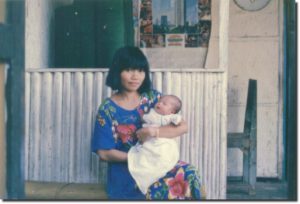 t work, modernity is never far away or totally separated from the traditional life. The kids blend them together without a thought. Their toys include store-bought dolls and laser guns, castoff plastic plates from a recent ceremony and some oddly shaped pebbles that have washed up from the sea in a recent storm. This kind of childhood is far from my own Chicago child life: we rarely interacted with adults, dads were at some sort of work that we only vaguely understood and moms were at home cooking and cleaning. Here it’s like Tom Sawyer and Kim all rolled into one, set against the beautiful Bali Sea in a somewhat seedy fishing kampung.
t work, modernity is never far away or totally separated from the traditional life. The kids blend them together without a thought. Their toys include store-bought dolls and laser guns, castoff plastic plates from a recent ceremony and some oddly shaped pebbles that have washed up from the sea in a recent storm. This kind of childhood is far from my own Chicago child life: we rarely interacted with adults, dads were at some sort of work that we only vaguely understood and moms were at home cooking and cleaning. Here it’s like Tom Sawyer and Kim all rolled into one, set against the beautiful Bali Sea in a somewhat seedy fishing kampung.
I’ve been trying to get a grasp on the issue of modernity versus tradition (if it’s really a binary thing, and it certainly doesn’t appear to be) in PNG, but it dawns on me that very similar processes are at work here. Maybe that’s what has thrown me off integrating my most recent trip to PNG into my somewhat idiosyncratic world view. I was having dinner with a few guests on the cruise ship and one of them remarked that my wife sounded very traditional.
That remark just came to mind today while I was cleaning the house and moving some of my wife’s traditional medicines out of the way.  The smell of jajan (a wonderful variety of baked goods) rises up to my room from my wife’s kitchen. She’s cooking for the 40-day ceremony for my new grandson. She still makes everything from scratch even though she could more easily buy the things she cooks in a bakery or supermarket. My wife is about as traditional as you can get here, but the tablet that she uses for her regular Facebook postings is never far from reach.
The smell of jajan (a wonderful variety of baked goods) rises up to my room from my wife’s kitchen. She’s cooking for the 40-day ceremony for my new grandson. She still makes everything from scratch even though she could more easily buy the things she cooks in a bakery or supermarket. My wife is about as traditional as you can get here, but the tablet that she uses for her regular Facebook postings is never far from reach.
Tradition and modernity are all around me, but I miss a lot of it because in so many ways, I really have (as I’ve been accused of by several former anthropologist colleagues) gone native for the most part and so what seems strange and exotic to Western outsiders is just another regular, non-remarkable event for me that I gloss over like so many of the ceremonies and colorful cultural artifacts that bring millions of visitors to this tiny island every year.
And then there’s tourism that gets thrown in this mix. I came here as a tourist as all of the foreigners who live here did, but over the years I’ve grown to view tourism mostly through its negative aspects. But tourism is one of the economic and cultural forces that I’ve come to reconsider after my month on the Sepik River. And accordingly, I need to do so here as well. Lots of things to reconsider; that in itself is actually refreshing as the events of the last six months have shaken me out of my tropical lull and started me on taking a look at the local and the foreign in some new ways.
The movement from tradition to modernity doesn’t have a simple linear trajectory; it twists and turns, advances and retreats. Some aspects of modernity are adopted and modified to fit into the regular flow of life; technology seems to be the easiest path to be adapted, ideology the hardest. And there’s the sticky problem of the definition of both modernity and tradition. 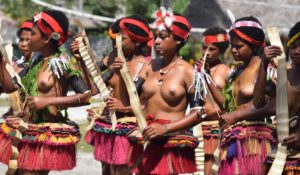 This is a current issue in many of the places that I’ve visited in PNG. What’s tradition, what’s custom, what’s good tradition, what’s bad, what’s the difference between tradition and custom. One example: are young ladies in the Trobriand following tradition when they dance topless in front of camera-clicking (and cash-paying) tourists? And if it’s tradition, is it good tradition or bad tradition. And then there’s land issues. Here the issue revolves less around land problems (a common point of contention in PNG) and more around how cultural actions are played out whether it’s in death rituals, religious rituals or the political translation and mobilization of the two.
This is a current issue in many of the places that I’ve visited in PNG. What’s tradition, what’s custom, what’s good tradition, what’s bad, what’s the difference between tradition and custom. One example: are young ladies in the Trobriand following tradition when they dance topless in front of camera-clicking (and cash-paying) tourists? And if it’s tradition, is it good tradition or bad tradition. And then there’s land issues. Here the issue revolves less around land problems (a common point of contention in PNG) and more around how cultural actions are played out whether it’s in death rituals, religious rituals or the political translation and mobilization of the two.
In both Indonesia and Papua New Guinea there are serious existential concerns about the viability of traditional culture under the onslaught of 21st century modernity and globalization. However, they are opposite sides of the same coin; 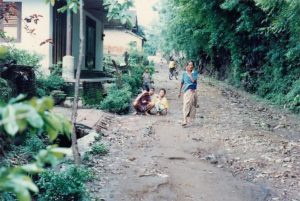 Bali is concerned with too much tourism, Papua New Guinea with too little. Finding a balance seems to be the commonsense solution to Bali’s problem, although the eyes of the powers that control such things here seem to be blinded by the color of money. It’s always the more the better. But this issue in Bali has been discussed since colonial days, and with no solution in sight, it’s easy enough to take the cynical view that nothing will change until the whole fragile system collapses under its own weight. For PNG, well that’s something for another post.
Bali is concerned with too much tourism, Papua New Guinea with too little. Finding a balance seems to be the commonsense solution to Bali’s problem, although the eyes of the powers that control such things here seem to be blinded by the color of money. It’s always the more the better. But this issue in Bali has been discussed since colonial days, and with no solution in sight, it’s easy enough to take the cynical view that nothing will change until the whole fragile system collapses under its own weight. For PNG, well that’s something for another post.
Thinking of Papua New Guinea: Part I,
I have some time today; Su and Zoey went south to visit her sister in the hospital. There’s some time then to get back to trying to unravel what’s happened to me during my 11 weeks in PNG. I’ve started two posts, but they have both started to unravel under some invisible weight of change – it’s the change thing that has me disoriented. I’m not sure if it’s a change in ideology, in worldview, or in some ambiguous theoretical stance (although to be honest, I lost my Marxist/Freudian theoretical stance during the crazy month thirty some years ago when I wrote my Ph.D. dissertation).
So, I’ve been flopping around the house since I returned from a month on the Sepik River, taking care of my granddaughter, fixing things around the house, and worrying about my children and grandchildren. But, running in the back of all this has been the need to get a grip on what happened in PNG.
Zoey has her bilums (net bags that everyone wears and uses in PNG and in Indonesian Papua as well, although they call them nokens over there) spread out all over her room; I didn’t  know if she would like them as gifts, but she stuffs things down inside and says, “I have a surprise inside my bilum, Grandpa, do you know what it is?” And then there are the masks that I brought back and have hanging on the wall and the sacred flutes that Zoey likes me to play. So PNG is in my awareness constantly.
know if she would like them as gifts, but she stuffs things down inside and says, “I have a surprise inside my bilum, Grandpa, do you know what it is?” And then there are the masks that I brought back and have hanging on the wall and the sacred flutes that Zoey likes me to play. So PNG is in my awareness constantly.
Living on a cruise ship is, in itself, a surrealistic enough experience, but add to that the destinations – small villages (and some not so small villages) and islands known to most of the outside world primarily through guide books and the anthropological writings of Margaret Mead, Gregory Bateson, Reo Fortune and a slew of folks who have followed up on their work.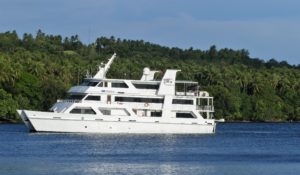 I just happened to find an anthropologist who had been through this experience years before me; another American living over in this corner of the world who had worked on the same cruise ship that I have just finished traveling on. She wasn’t an academic anthropologist, she called herself (at least on her blog) as an applied anthropologist, and it turned out she had a blog where she wrote about her life in PNG.
I just happened to find an anthropologist who had been through this experience years before me; another American living over in this corner of the world who had worked on the same cruise ship that I have just finished traveling on. She wasn’t an academic anthropologist, she called herself (at least on her blog) as an applied anthropologist, and it turned out she had a blog where she wrote about her life in PNG.
Unfortunately, she passed away in one of those unexplained and tragic auto accidents while she was back visiting in the US. But she has this blog that is still online and through it, I’ve started to get some feel for what it may be that I’m looking for.
A Jump Start from the Homeland
I was looking back on what I wrote above yesterday while watching the always depressing news about what is happening in Trumpland, and the realization suddenly hit me that what I’ve been thinking around – not able to get to it head-on for some reason – and what it was that startled me about being in PNG was resilience.
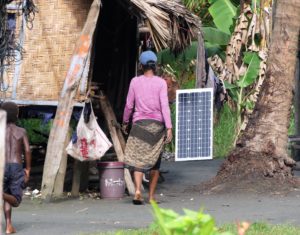
Kopar Village, PNG
Despite everything, all the difficulties of living in remote areas with no immediate access to education and health care and often running water, as well as the lack of direct assistance from the government, was the sense of the resilience of the people that I met over 11 weeks. They are working on finding the path that leads to a successful blending of modernity and tradition. And with that, I’ll leave more until the next post.
The History of the Bugis in Kampung Bugis Part II
Note: Back on the old blog before I lost my domain name, I had a history of Kampung Bugis that I translated from the Indonesian. This document was a senior thesis written by an Indonesian student. It was an interesting history, and unfortunately I’ve misplaced most of the translation except for this section, I’m posting this here with the hope that I will come across the rest of the translation in the future.
Last post on the Bugis, I wrote that I would add some information about the culture of the Bugis who arrived in Bali. This post summarizes the information in from the first section of Chapter 2 of the Migration and the Role of the Bugis in Kampung Bugis Buleleng 1815-1946 by I Nyoman Mardika.
According to Raden Sasrawidjaja who wrote about the Bugis in Kampung Bugis in 1871 when he visited there, the houses of the Bugis who came to Bali had three parts: an upper house under the roof called the Rakkaang where grain, other food supplies and family heirlooms were stored, unmarried girls from the nobility also lived in this section of the house; the second part of the house, the Alebola, consisted of rooms that were used for living, such as bedrooms, a kitchen, a dining room and a receiving room; the third part, the Awasai, was used for livestock, farming gear or fishing gear.
The original geographic boundaries of Kampung Bugis were unclear because there were no firm agreements on borders at this time, but after Indonesia won independence the boundaries of Kampung Bugis were the Java Sea to the north, Tukad Buleleng to the east, Kampung Anyar to the west and Banjar Bali to the south. The population of Kampung Bugis in 1823 was estimated to be around 2,000 residents. The current population is around 3,300.
Kampung Bugis was ideally located for the Bugis people because it is located along the beach close to the center of the town of Singaraja. It is also adjacent to to the customs port of Buleleng. Because this customs port was busy and visited regularly by ships, it was an ideal location for the Bugis who were skilled in trading activities. Also, due to Kampung Bugis’ relatively small, narrow boundaries and sandy soil, farming was not an option as an economic activity. So, the Bugis traded as their main means of livelihood with fishing as a secondary source of income or food. The writer notes that the Bugis are known for their trading ability because of their tradition of sailing and dominating inter-island trade prior to the Dutch intrusion into the islands.
In order to be able to understand the history of the Bugis people in Kampung Bugis, it is necessary to view the kampung and the people in the context of north Bali, or Buleleng. The city of Singaraja was founded in 1604 by I Gusti Panji Sakti who came to the north from the kingdom of Gelg el in the south. Sakti, according to the Babad Buleleng, traced his descent back to the fabled Majapahit Empire in Java. Sakti’s descendents ruled Buleleng until the late 18th century when the kingdom was taken over by Karangasem. By 1840 Buleleng was ruled by Anak Agung Ngurah Made Karangasem along with the powerful prime minister I Gusti Ketut Jelantik. Under his charismatic leadership, Buleleng became one of the most powerful kingdoms on the island. But, the Dutch, who had paid little substantial attention to Bali up until the 18th century because of its lack of spices, became interested in securing treaties with the Balinese kings in order to establish themselves on the island so that any British ambitions for Bali would be abandoned. By 1845 the Dutch had successfully established treaties with most of the Balinese kingdoms.
el in the south. Sakti, according to the Babad Buleleng, traced his descent back to the fabled Majapahit Empire in Java. Sakti’s descendents ruled Buleleng until the late 18th century when the kingdom was taken over by Karangasem. By 1840 Buleleng was ruled by Anak Agung Ngurah Made Karangasem along with the powerful prime minister I Gusti Ketut Jelantik. Under his charismatic leadership, Buleleng became one of the most powerful kingdoms on the island. But, the Dutch, who had paid little substantial attention to Bali up until the 18th century because of its lack of spices, became interested in securing treaties with the Balinese kings in order to establish themselves on the island so that any British ambitions for Bali would be abandoned. By 1845 the Dutch had successfully established treaties with most of the Balinese kingdoms.
Next post: The Dutch Capture of Buleleng
Once Again Back On the Road: Another Ubud Trip (Where Else?)
I’ve been back from my latest trip to Papua New Guinea for almost two months now. I’ve been working on writing about the changes in me that those trips have brought about, but I haven’t quite completed figuring the whole thing out – but soon, it’s just on the tip of my tongue.
After being out on the sea for three months out of five (before these two months at home), life in the kampung has gotten a bit ho-hum. Everyday is the same: get up, play with Zoey before school, get her off to school, clean the house, play with Zoey after school, do a little reading and writing, play with Zoey again while my wife makes dinner, eat dinner, watch tv and sleep, Reset and do it all again tomorrow.
Now, that’s actually not a bad life. I don’t have to work; I wouldn’t mind having some extra money, but we have enough to get by on, and for me that’s cool. I have a great bunch of kids and grandkids. Somehow all the neurological problems that I had a few years back after a stroke have disappeared. I live on a tropical island, which I’ve wanted to do since I was in high school. I speak two languages and bits of three or four other ones. I have a beautiful and extremely challenging wife. I have a completely strange and blind monkey that I would love more if he didn’t insist on peeing on me.
So, what I have always needed when I get these stay-at-home blues is a road trip, and where else to make a trip other than to Ubud to visit some old friends and see what the Yoga capital of the world is up to these days. Really the trip is not just about visiting friend or getting out of the house. It’s as much about seeing Bali. Getting out to the villages and the small roadside warungs and life outside of tourism central.
Life on this small island now regularly called a resort island (how ugly can we get) has always been about what happens with the masyarakat (the people). All the rest is window dressing for anthropologists, royalty-struck tourist hangers-on, and, of course, the wealthy and connected. And for me, the best way to get to see what is going on around the island is to head out on my motorcycle and make a few stops along the way to chat with folks. The destination of Ubud is really of secondary importance to the physical act of the ride over these twisty roads that run through some of the best of traditional Balinese villages.
The weather on the trip down and back was beautiful: clear skies, a slight breeze and that Balinese sun to keep me warm when I got up into the mountains just before Kintamani.
These trips give me a chance to let the thoughts flow freely, unencumbered by the daily trivia of life back home. My children call these trips “refreshing,” and while I used to think that was kind of a strange way to put it, it’s actually the perfect word to describe what happens when I get out on the road. On 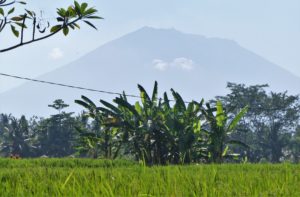 this trip, I was playing with the concept of consciousness (not in the sense of how some of the new arrivals to Bali use it, such as in “Oh ya, I’m a conscious person,” but in the scientific sense of the word.) Consciousness is a favorite concept to think about just because of the act of perceiving and thinking about the beauty found around Bali on the way up to Ubud from Singaraja. The sense of being in the world can be really startling when immersed in the lushness of a tropical island.
this trip, I was playing with the concept of consciousness (not in the sense of how some of the new arrivals to Bali use it, such as in “Oh ya, I’m a conscious person,” but in the scientific sense of the word.) Consciousness is a favorite concept to think about just because of the act of perceiving and thinking about the beauty found around Bali on the way up to Ubud from Singaraja. The sense of being in the world can be really startling when immersed in the lushness of a tropical island.
By the end of the drive, I was, as is said, refreshed. Down in Ubud, things are as busy as usual; the tourist season really doesn’t exist anymore for Ubud, it’s always the tourist season. The narrow sidewalks that were once a pleasure to stroll along in early May before the onslaught of the traditional tourist season that began in June, now are packed in early May with the wandering hordes of tourist walking two or three abreast making it difficult to do an absent-minded stroll. Seems like there is always someone pushing you off towards the street, which is extremely hazardous with all the traffic in Ubud these days.
I had a chance to catch-up with the Balinese family that I have been staying with for the past 29 years, as well as spe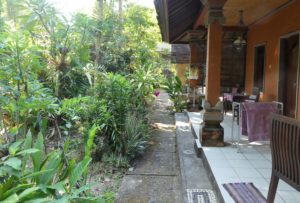 nding a pleasant afternoon catching up with an old American friend and his Balinese wife. And, as usual, I did my shopping tour through town to get a few things for Zoey, Zander and Su. I made my obligatory stop at Ganesha Books to get Zoey a few books, and I succumbed to the desire to spend a quiet evening in my room by ordering a pizza from a local restaurant.
nding a pleasant afternoon catching up with an old American friend and his Balinese wife. And, as usual, I did my shopping tour through town to get a few things for Zoey, Zander and Su. I made my obligatory stop at Ganesha Books to get Zoey a few books, and I succumbed to the desire to spend a quiet evening in my room by ordering a pizza from a local restaurant.
Getting out of town is for me a chance to get out of a few of the daily routines, and this trip was successful and pleasant. And now back home to start on some new projects.





